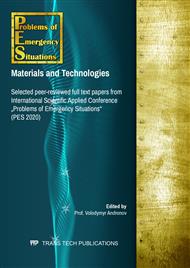[1]
Seema Pattanaik, Vikas Bvj, Bikash Pattanaik, Shailendra Sahu, Denture stomatitis: a literature review, Journal of Indian Academy of Oral Medicine and Radiology. 22(3) (2010) 136-140.
DOI: 10.5005/jp-journals-10011-1032
Google Scholar
[2]
Avadhesh Kumar Chaubey, Sunil Kumar Mishra, Ramesh Chowdhary, Positive material identification testing of dental implant to correlate their compositions with allergic conditions, Journal of Oral Biology and Craniofacial Research. 9(3) (2019) 294.
DOI: 10.1016/j.jobcr.2019.05.003
Google Scholar
[3]
N.V. Yaschikovskiy, L.S. Velichko, A.I. Kulak, Vliyanie tehnologicheskih faktorov na korrozionno-elektrohimicheskie protsessyi, prohodyaschie na poverhnosti stomatologicheskih splavov 1H18N9T, Sovremennaya stomatologiya, Minsk. 2 (2007) 67–70 [in Russian].
Google Scholar
[4]
M.G. Schogoleva, Elektrohimicheskie protsessyi v polosti rta patsientov, Medichni nauki. Scientific journal Science Rise,. 12/3(17) (2015) 72–76 [in Russian].
Google Scholar
[5]
L.R.L. Aboud, F. Ormiga, J.A.C. P. Gomes, Electrochemical induced dissolution of fragments of nickel-titanium endodontic files and their removal from simulated root canals International Endodontic Journal. (2013) n/a.
DOI: 10.1111/iej.12126
Google Scholar
[6]
Mohd Talha, Yucong Ma, Yuanhua Lin, Yong Pan, Xiangwei Kong, O.P. Sinha and C.K. Behera, Corrosion performance of cold deformed austenitic stainless steels for biomedical applications, Corrosion Reviews. 37(4) (2019) 283-306.
DOI: 10.1515/corrrev-2019-0004
Google Scholar
[7]
J. Mystkowska, K. Niemirowicz-Laskowska, D. Łysik, G. Tokajuk, J.R. Dąbrowski, R. Bucki, The role of oral cavity biofilm on metallic biomaterial surface destruction–corrosion and friction aspects, Int. J. Mol. Sci. 19 (2018) 743.
DOI: 10.3390/ijms19030743
Google Scholar
[8]
G. Bayramoğlu, T. Alemdaroğlu, S. Kedici, A.A. Aksüt, The effect of pH on the corrosion of dental metal alloys, J Oral Rehabil. 27(7) (2000) 563-75.
Google Scholar
[9]
L.S. Velichko, N.V. Yaschikovskiy, Zabolevaniya, obuslovlennyie materialami zubnyih protezov, Meditsinskiy zhurnal. 2 (2010) 38-44 [in Russian].
Google Scholar
[10]
G. Lei, X. Hong, Corrosion of dental metal and alloy materials in oral application, Journal of Clinical Rehabilitative Tissue Engineering Research. 14(21) (2010) 3961-3964.
Google Scholar
[11]
A.V. Yumashev, A.S. Utyuzh, M.V. Mikhailova, V.O. Samusenkov, I.R. Volchkova, Selecting clinical and laboratory methods of manufacture of orthopaedic titanium alloy structures using a biopotentiometer, Current science. 114(4) (2018) 891-896.
DOI: 10.18520/cs/v114/i04/891-896
Google Scholar
[12]
Ivica Richter, Ivan Alajbeg, Vanja Vučićević Boras, Ana Andabak Rogulj, Vlaho Brailo, Mapping electrical impedance spectra of the healthy oral mucosa: a pilot study, Acta Stomatol Croat. 49(4) (2015) 331-339.
DOI: 10.15644/asc49/4/9
Google Scholar
[13]
Andréa Pereira Morais, Alexandre Visintainer Pino, Marcio Nogueira Souza, Assessment of Tooth Structure using an Alternative Electrical Bioimpedance Spectroscopy Method, Braz. Dent. J. 25(2) (2014).
DOI: 10.1590/0103-6440201302316
Google Scholar
[14]
N.D. Omelyanenko, D.K. Guscha, Izmerenie soprotivleniy tkaney polosti rta: osobennosti, posledovatelnost, nezamechennyie oshibki. Sovremennaya stomatologiya. 4 (2009) 22 [in Russian].
Google Scholar
[15]
V.F. Kutsevlyak, O.K. Sevidova, M.G. Schogoleva, O.V. Vasilchenko, Sposib diagnostiki galvanoziv. Deklaratsiyniy patent na vinahid. 55906, A, Ukrayina, MPK 7 A61V10/00, A61S5/08 [in Ukrainian].
Google Scholar
[16]
A.V. Zhidovinov, Obosnovanie primeneniya kliniko-laboratornyih metodov diagnostiki i profilaktiki galvanoza polosti rta u patsientov s metallicheskimi zubnyimi protezami.: Avtoreferat dissertatsii k. med. n., Volgograd, 2013 [in Russian].
Google Scholar
[17]
A.A. Timofeev, Pokazateli potentsiometrii i nespetsificheskoy rezistentnosti organizma u patsientov s metallicheskimi vklyucheniyami v polosti rta, fiksirovannyimi na dentalnih implantatah i zubah, Sovremennaya stomatologiya. 4 (2005) 133-138 [in Russian].
Google Scholar
[18]
F.V. Mihalchenko, A.V. Zhidovinov, L.I. Denisenko, Korroziya metallov polosti rta kak faktor razvitiya galvanoza, Sovremennyie problemyi nauki i obrazovaniya. 3 (2015) [in Russian].
Google Scholar


